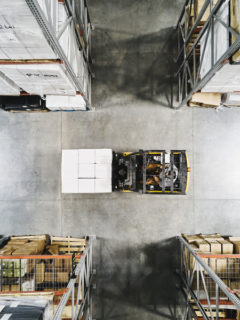Undeniably, optimising your packaging station offers several advantages to your business. The constant effort to improve the space for preparing your orders(packing) is a common feature among all logistics specialists. After all, a good packing station is crucial for efficient, profitable and fast outbound logistics.
1. Organise the inbound and outbound flow of your warehouse
Certainly, order preparation spaces in a warehouse should be located in an intermediate location between incoming and outgoing goods flows. In addition, it is essential that the different areas of the warehouse be delimited in order to avoid accidents and facilitate transit.
- Provide adequate information on coding both at the entrance to the order preparation areas and in the rest areas. It will certainly be very useful for people who are not familiar with these areas, such as suppliers or temporary workers;
- Take the goods to the packing station. Once the products are separated, they are stored in an area close to the person in charge of orders. To transport the goods, use, for example, trolleys or roll-containers;
- Colour-coded marking on the floor will help to delimit the different areas of the warehouse. As a result, you can use signposting and demarcation tapes.
For example, it organises different types of packing stations according to the nature of the product to be packed? Standard, fragile, large formats, among others? This method allows each post to have its specific tools and packaging, gaining speed and efficiency.
Automatic prevention systems to gain safety at the packaging station
Above all, a good option to gain safety is to make use of the advantages of logistics 4.0 and implement automatic risk prevention systems in the warehouse. In this way, those responsible for the orders will work more efficiently and comfortably. The possibilities available on the market include:
- Suspended monorails for handling loads: they leave the floors free, which makes cleaning easier, and consequently prevents any falls that may occur;
- Emergency buttons. They must be located at strategic points in the warehouse, and at least one of them must be within reach of the packing station area. In case of accident or danger, simply activate it to instantly stop the operation of all machines;
- Movement detection sensors. They emit audible and luminous signals when people or objects approach. They are therefore vital in preventing accidents.
2. Organise your packing station
Once we have properly delimited and conditioned the space where the packing station will be located, we proceed to determine its configuration, the tools we will use and the layout of each of its components.
What elements are included in a packaging station?
Packing stations are assembled combining a selection of the following elements:
- Packing table. This is the main work space. It must be adjustable, in height, so that the user can adapt it and work without straining their posture;
- Shelves. Tilting and extendable to allow better access and movement as required;
- Drawers. For organising packing materials and tools;
- Extensible bars. For placing consumables and sheets such as kraft paper, tissue paper or foam film;
- Light system. Led and adjustable in intensity;
- Roll holder. For roll consumables, including kraft paper, foam, bubble wrap or drying paper;
- Cutter bars. For cutting different materials to size.
- Racks. To provide a fixed place for accessories. That is: for example, for the computer or the adhesive tape;
- Swivel arms. For modulating stands and shelves.
Select the required tools and accessories
Choose the location of your tools/accessories according to the frequency of use:
- Tools and materials must always be at hand for the order taker: the packaging (boxes, cases, envelopes…), the tape dispenser, the label printer, the bin… and all the packaging and filling elements that are used regularly;
- Tools and materials that are used frequently should also be nearby: protection for fragile products, replacement of adhesive tape, etc;
- Material that is used occasionally should be placed in the work area to be used if necessary: very specific packaging formats, x-atos, among others.
It is, therefore, very important that all the material to be used is properly organised.
RAJA offers 100% customised packing stations to suit your every need. As a result, choose a packaging station that is tailor-made to suit your needs!
How to have a more Eco-Responsible packing station?
With a few small gestures, you too can find a more Eco-Responsible packing station. Put into practice the 5Rs of packaging by considering:
- Reuse waste. For example, cardboard scraps that can be transformed into filling material with the help of the cardboard perforator;
- Recycle waste by disposing of it selectively to facilitate its collection and processing;
- Replace standard packaging materials with eco-friendly alternatives.
3. Ergonomics of the packing station
In summary, you now know where to locate the packing station in the warehouse. Next, you have to build your packing station with the objective of guaranteeing optimal working conditions (speed and efficiency combined with comfort).
The packing station is composed of:
- A flat work surface;
- Shelves with or without dividers, to hold different packaging and accessories;
- Adjustable bars to place the rolls (cardboard or bubble wrap);
- A space for waste.
When arranging all these components, it is essential to take care of ergonomics. Among the most common injuries to warehouse operators are musculoskeletal disorders, fatigue and excessive effort. In this sense, anticipating risks and avoiding most of these incidents is fundamental.
Position and function of each space within the packing station
- The top shelf accommodates the most used cardboard boxes or envelopes of different sizes, which thanks to the dividers can be easily collected.
- The middle shelf should hold objects that are needed quite frequently: adhesive tapes, tissue paper, label printers, etc. For example, some users place the air cushion dispenser box.
- The bars are used to place the stuffing box or the labels (although this is optional).
- The document holder (for an internal packaging manual, for example) must be placed at eye level.
- If you are a company that packs a lot of products on a daily basis, a packaging system that can be installed directly on the table is recommended. This is possible with a simple paper filling system such as the Fill Pack M or the Fill Pack TT.
Tip: depending on the number of hours spent in the packing station, we recommend the use of other accessories:
- Anti-fatigue mats that relieve pressure on the feet and stimulate blood circulation;
- Drums although this depends on the nature and formats of the products to be packaged;
- Stackableplastic boxes that facilitate picking work and minimise manual handling.
Types of packing station: complete or modular?
When acquiring a packaging station for your warehouse, you should consider
- Complete packaging station. In short, it is the most suitable solution for most warehouses, as it has all the equipment necessary to meet the needs of those in charge;
- Modular packaging station. It is totally customizable, allowing you to choose the ideal configuration and adapt it to the characteristics of your company.
At RAJA we are packaging specialists! If you need advice, contact our specialists on 707 788 008 or by email: contacto@rajapack.pt. They will be happy to help you choose which solutions best suit your business.














